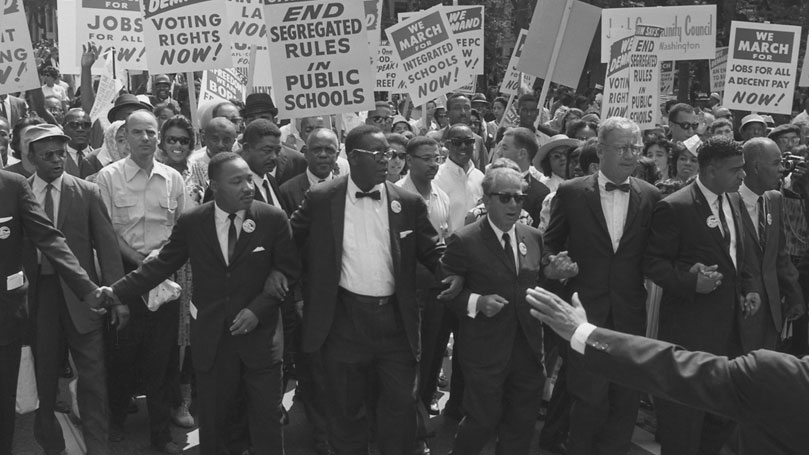
The following were opening remarks by Jarvis Tyner, national vice chairman of the CPUSA, in a recent teleconference call.
Dr. Martin Luther King was so eloquent when he spoke of the arc of humanity; that it “is long, but it bends towards justice.”
I don’t think this was blind optimism on his part, but optimism based on a political understanding and knowledge of the history of struggle for freedom that has made great advances over the centuries. Based on that understanding Dr. King believed the people would ultimately win. Our party shares in that belief.
Frederick Douglass’ view that without struggle there is no progress suggests that with struggle there is progress. The history of the African-American people is a history of struggle. That is how we got here and that is how we will win as a group.
With struggle there is progress.
After over 300 years of struggle against the most oppressive and cruel system of chattel slavery, waged by the slaves themselves with a predominantly white abolitionist movement, slavery was overthrown; the struggle succeeded.
It was the struggle of the slaves themselves – their resistance to this cruelty – that forced onto the center stage the great debate over whether this nation would realize the democracy and freedoms contained in the Declaration of Independence and the U.S. Constitution or remain a nation on the road to self destruction.
It took the Civil War (still the bloodiest war in our history) to end slavery and establish the United States of America. That’s how important the black question was.
The African-American people’s struggle for freedom was then – and remains today – central in the fight for democracy and progress.
From the struggles against slavery to today’s struggle against structural racism and for democracy for all, the African-American people continue to play a strategic role in the fight for progress.
Because U.S. racism and capitalism are solidly linked, the fight against racism and for equality has always also had great revolutionary potential.
That centrality of the struggle of the African-American people is rooted in a culture of struggle and resistance that made it possible to survive the horrors of human bondage and 90 years of Jim Crow: extreme poverty, genocidal racist violence and economic terror.
A culture of struggle has been forged in the hard fights against slavery and Jim Crow and the refusal of black people to accept the indignities and insults they were expected to endure.
This culture of struggle is indelibly etched on the basic progressive and democratic political consciousness and basic character of the African Americans.
There is clearly a minority of black Americans, however, depending on the issues, who are not with the program, so to speak. Some are even in denial of the reality of racial oppression and think there is a pot of gold waiting for them at the end of the Republican tea party rainbow.
Black people are overwhelmingly in the working class and they are struggling against big business, landlords, banks and bosses every day. In their world black, conservatives are the exception.
When the African American vote for Obama is well over 90 percent – that is real black unity. That is acting as one.
Obama’s attraction however, is far is more than just his race.
Obama is a liberal but on some questions he is much more than a liberal. He articulated deeply held hopes and dreams… and it moved the American people and the African-American people is a special way.
In 2008 black voters and young voters broke all kinds of turnout records because they understood the grave dangers of cutting programs, stealing elections, attacking the basic right to vote and destroying unions.
They understand “stand your ground” and the murder of Trayvon Martin. They understood Scottsboro, Emmett Till, Medgar Evers and Chaney, Schwerner and Goodman.
So many families were experiencing the incarceration of their young people, mainly over drugs and stop and frisk laws. They were marching and demonstrating and using their vote to push back against the “New Jim Crow.”
The extreme right-wing Republicans are leading the charge on all these issues. But some liberals also go along with these policies, which are promoted by the most reactionary sections of the 1 percent.
It is clear to all who want to see, however, that these policies come from the extreme right and if you want to get rid of the policies, the racist politicians who sponsor them have to be defeated.
These right-wing hucksters are addicted to racism, war and war spending and think nothing of locking our young people away in prison and permanently trapping our families in unemployment and underemployment to protect their power and their profits.
Our people are entrapped in the hell that is deep poverty because these same politicians believe that profits come before people.
Currently, 25 percent of African Americans and 50 percent of African-American youth are trapped in unemployment or underemployment.
In some communities the number of unemployed youth is over 60 percent. Then they cut money for education and social programs, they bring in the drugs and the guns and they criminalize our youth, blaming them for policies they did not create.
We say: we need jobs not guns, decent schools and affordable housing – not more jails.
The fight against racism today is key to defeating the entire agenda of the extreme right.
We are not going back!
In fact, we must step up the struggle against racism. It is through the kind of initiatives like the Moral Mondays, the new movements among low paid workers – movements like the Walmart workers have initiated, the immigrant rights movement, the “Fast Food Forward” movement and the hundreds of labor-backed community action groups that progress will be made.
They are fighting for racial justice as they fight for economic justice. That joining of the struggle must be a part of all the new working-class movements.
We have to understand that the fight against racism must include battling the vile racism directed at President Obama himself and at other members of his administration.
It becomes necessary to realize then that while we can disagree with the president the question of how we disagree with him is an important one.
He holds the highest office in the land and the right wing – like Wallace standing in the doors of University of Alabama in 1963 – will never accept the reality of a black president.
For those who still think Obama’s election has not been an election of historic significance, I ask that we visualize what it would have been like to have a John McCain or Mitt Romney in the White House.
Imagine one of them in the White House with the GOP majority in the House, the close numbers in the Senate and the Supreme Court the way it is. Tragically, the situation in the nation would today be far worse than it actually is.
If we want real change we must support the new movements we have talked about, help them stay united and help them to find the way to victory.
They can win this fight against economic and racial inequality and we must be there with them in both the fight and the victory. These billion dollar burger, chicken, pizza and retail corporations are not invincible. They can be defeated.
The same solidarity needs to be extended to the embattled public workers who have a high percentage of black and other workers of color and are fighting for their lives. This is part of the fight against racism too.
The strategic role of the African-American people’s struggle has to do with their being over 90 percent working class and being on the bottom of the economic ladder for so long. It grows out of an understanding of the unity of race and class consciousness; forged in the crucible of struggle against racial and class oppression. African Americans join unions for example, at a rate higher then any other racial group.
And their role is indispensable to defending and advancing the U.S. labor movement and the overall fight for democracy.


 Join Now
Join Now